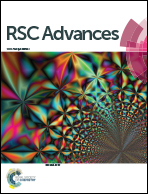Electrokinetic properties and stability of cerium dioxide suspensions†
Abstract
The dispersed ceria particles synthesized by destruction (heating) of the double salts of cerium and ammonium nitrate have been determined to be porous. The surface charge density and electrokinetic potential of the particles have been measured by potentiometric titration and micro-electrophoresis. The point of zero charge (pzc) corresponds to pH 5.6 in water and pH 5.2 in 0.001 M KCl solution, whereas the isoelectric point remains around pH 5.8 for both solutions. Constant (negative) values of the ζ-potential in 0.001–0.01 M KCl solutions have been measured; however, at higher salt concentrations, a gradual decrease of the ceria electrokinetic potential has been observed. Addition of CaCl2 and AlCl3 or LaCl3 obtains a considerable decrease in the ζ-potential of the particles and changes the sign correspondingly. After ultrasonic treatment of the suspension, a monomodal particle size distribution with an average particle size of 0.6 μm was measured. Moreover, the laws of aggregation of CeO2 particles as a function of aging, pH, shear conditions and the concentration of added KCl and CaCl2 solutions have been studied. The obtained results can be explained from the viewpoint that micron-sized strongly hydrated CeO2 particles have a tendency to aggregate over the time under applying shear force or in the presence of electrolytes in a secondary minimum with the formation of loose, easily destroyable and renewable aggregates.


 Please wait while we load your content...
Please wait while we load your content...